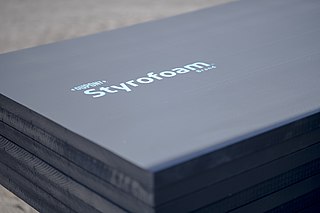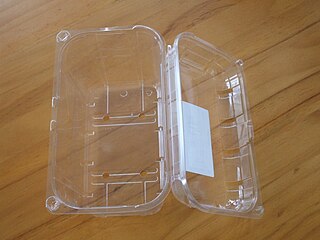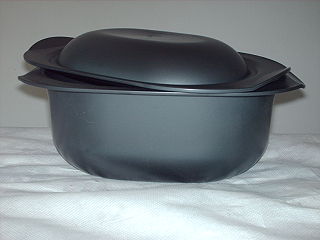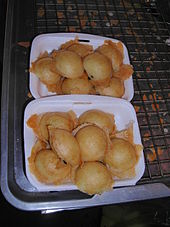
Polystyrene (PS) is a synthetic polymer made from monomers of the aromatic hydrocarbon styrene. Polystyrene can be solid or foamed. General-purpose polystyrene is clear, hard, and brittle. It is an inexpensive resin per unit weight. It is a poor barrier to air and water vapor and has a relatively low melting point. Polystyrene is one of the most widely used plastics, with the scale of its production being several million tonnes per year. Polystyrene is naturally transparent, but can be colored with colorants. Uses include protective packaging, containers, lids, bottles, trays, tumblers, disposable cutlery, in the making of models, and as an alternative material for phonograph records.

A thermoplastic, or thermosoftening plastic, is any plastic polymer material that becomes pliable or moldable at a certain elevated temperature and solidifies upon cooling.

Styrofoam is a trademarked brand of closed-cell extruded polystyrene foam (XPS), manufactured to provide continuous building insulation board used in walls, roofs, and foundations as thermal insulation and as a water barrier. This material is light blue in color and is owned and manufactured by DuPont. DuPont also has produced a line of green and white foam shapes for use in crafts and floral arrangements.

Take-out or takeout is a prepared meal or other food items, purchased at a restaurant or fast food outlet with the intent to eat elsewhere. A concept found in many ancient cultures, take-out food is common worldwide, with a number of different cuisines and dishes on offer.

A drinking straw is a utensil that is intended to carry the contents of a beverage to one's mouth. Disposable straws are commonly made from plastics. However, environmental concerns related to plastic pollution and new regulation have led to rise in reusable and biodegradable straws. Following a rise in regulation and public concern, some companies have even voluntarily banned or reduced the number of plastic straws used. Alternative straws are often made of reusable materials like silicone or metal or alternative disposable and biodegradable materials like paper, cardboard, pasta, or bamboo.

A coffee cup is a container, a cup, for serving coffee and coffee-based drinks. There are three major types: conventional cups used with saucers, mugs used without saucers, and disposable cups. Cups and mugs generally have a handle. Disposable paper cups used for take-out sometimes have fold-out handles, but are more often used with an insulating coffee cup sleeve.

A disposable is a product designed for a single use after which it is recycled or is disposed as solid waste. The term is also sometimes used for products that may last several months to distinguish from similar products that last indefinitely. The word "disposables" is not to be confused with the word "consumables", which is widely used in the mechanical world. For example, welders consider welding rods, tips, nozzles, gas, etc. to be "consumables", as they last only a certain amount of time before needing to be replaced. Consumables are needed for a process to take place, such as inks for printing and welding rods for welding, while disposable products are items that can be discarded after they become damaged or are no longer useful.

An oyster pail is a folded, waxed or plastic coated, paperboard container originally designed to hold oysters. It commonly comes with a handle made of solid wire. It is often used by American Chinese cuisine restaurants in the United States to package take-out food. It can also be found in other Western countries, such as Australia, New Zealand, Germany, Poland, England and Brazil, but is rarely seen in China and other Asian countries with high numbers of ethnic Chinese.

A paper cup is a disposable cup made out of paper and often lined or coated with plastic or wax to prevent liquid from leaking out or soaking through the paper. It may be made of recycled paper.

Commodity plastics or commodity polymers are plastics produced in high volumes for applications where exceptional material properties are not needed. In contrast to engineering plastics, commodity plastics tend to be inexpensive to produce and exhibit relatively weak mechanical properties. Some examples of commodity plastics are polyethylene, polypropylene, polystyrene, polyvinyl chloride, and poly(methyl methacrylate). Globally, the most widely used thermoplastics include both polypropylene and polyethylene. Products made from commodity plastics include disposable plates, disposable cups, photographic and magnetic tape, clothing, reusable bags, medical trays, and seeding trays.

Rigid panel insulation, also referred to as continuous insulation, can be made from foam plastics such as polyurethane (PUR), polyisocyanurate (PIR), and polystyrene, or from fibrous materials such as fiberglass, rock and slag wool. Rigid panel continuous insulation is often used to provide a thermal break in the building envelope, thus reducing thermal bridging.

As with many countries, pollution in the United States is a concern for environmental organizations, government agencies and individuals.

Disposable food packaging comprises disposable products often found in fast-food restaurants, take-out restaurants and catering establishments. Typical products are foam food containers, plates, bowls, cups, utensils, doilies and tray papers. These products can be made from a number of materials including plastics, paper, bioresins, wood and bamboo.

Plastics are a wide range of synthetic or semi-synthetic materials that use polymers as a main ingredient. Their plasticity makes it possible for plastics to be moulded, extruded or pressed into solid objects of various shapes. This adaptability, plus a wide range of other properties, such as being lightweight, durable, flexible, and inexpensive to produce, has led to its widespread use. Plastics typically are made through human industrial systems. Most modern plastics are derived from fossil fuel-based chemicals like natural gas or petroleum; however, recent industrial methods use variants made from renewable materials, such as corn or cotton derivatives.

A clamshell is a one-piece container consisting of two halves joined by a hinge area which allows the structure to come together to close. Clamshells can be made to be reusable and reclosable or can be sealed securely.
A plastic bag ban or charge is a law that restricts the use of lightweight plastic bags at retail establishments. In the early 21st century, there has been a global trend towards the phase-out of lightweight plastic bags. Single-use plastic shopping bags, commonly made from low-density polyethylene (LDPE) plastic, have traditionally been given for free to customers by stores when purchasing goods: the bags have long been considered a convenient, cheap, and hygienic way of transporting items. Problems associated with plastic bags include use of non-renewable resources, difficulties during disposal, and environmental impacts. Concurrently with the reduction in lightweight plastic bags, shops have introduced reusable shopping bags.

A disposable cup is a type of tableware and disposable food packaging. Disposable cup types include paper cups, plastic cups and foam cups. Expanded polystyrene is used to manufacture foam cups, and polypropylene is used to manufacture plastic cups.

Plastic containers are containers made exclusively or partially of plastic. Plastic containers are ubiquitous either as single-use or reuseable/durable plastic cups, plastic bottles, plastic bags, foam food containers, Tupperware, plastic tubes, clamshells, cosmetic containers, up to intermediate bulk containers and various types of containers made of corrugated plastic. The entire packaging industry heavily depends on plastic containers or containers with some plastic content, besides paperboard and other materials. Food storage nowadays relies mainly on plastic food storage containers.

Disposable tableware includes all disposable tableware like

In the late 20th and early 21st century, there has been a global movement towards the phase-out of polystyrene foam as a single use plastic (SUP). Early bans of polystyrene foam intended to eliminate ozone-depleting chlorofluorocarbons (CFCs), formerly a major component.





















